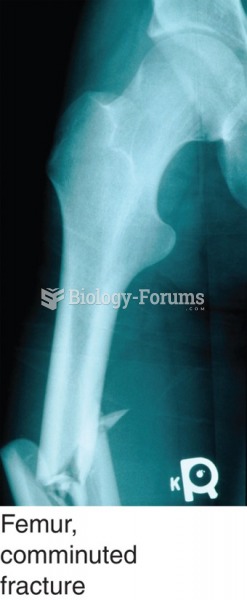Answer to Question 1
Correct Answer: 2
Rationale 1: Using short-term therapy and counseling is incorrect because while short-term therapy might be indicated, some clients require therapy for the rest of their lives.
Rationale 2: When a client is eating or drinking fewer nutrients than required for normal body growth and maintenance, undernutrition occurs. It can also occur in certain malabsorption disorders of the intestinal tract. The two primary goals in treating undernutrition are to identify the specific type of deficiency and to supply the missing nutrients.
Rationale 3: Using nutritional supplements and medication is incorrect because nutritional supplements might be needed for short-term therapy or for the remainder of the client's life.
Rationale 4: Treating the cause aggressively and allowing the client to gain weight is incorrect because gaining weight might not be a goal of undernutrition treatment.
Global Rationale: When a client is eating or drinking fewer nutrients than required for normal body growth and maintenance, undernutrition occurs. It can also occur in certain malabsorption disorders of the intestinal tract. The two primary goals in treating undernutrition are to identify the specific type of deficiency and to supply the missing nutrients. Using short-term therapy and counseling is incorrect because while short-term therapy might be indicated, some clients require therapy for the rest of their lives. Using nutritional supplements and medication is incorrect because nutritional supplements might be needed for short-term therapy or for the remainder of the client's life. Treating the cause aggressively and allowing the client to gain weight is incorrect because gaining weight might not be a goal of undernutrition treatment.
Answer to Question 2
Correct Answer: 3
Rationale 1: Irritation of the gastric tube along the stomach serosa is incorrect because the gastric tube does not lie along the serosa.
Rationale 2: An allergic reaction to the feeding is incorrect because while an allergic reaction to the formula might produce these symptoms, the more likely cause is how much and what type of formula the client is receiving.
Rationale 3: Clients sometimes exhibit vomiting, nausea, or diarrhea when first receiving enteral nutrition. Therapy should be started slowly with small quantities so that side effects such as nausea, diarrhea, and vomiting can be assessed.
Rationale 4: A viral agent common to clients with feeding tubes is incorrect because feeding tubes do not make the client more susceptible to viruses.
Global Rationale: Clients sometimes exhibit vomiting, nausea, or diarrhea when first receiving enteral nutrition. Therapy should be started slowly with small quantities so that side effects such as nausea, diarrhea, and vomiting can be assessed. Irritation of the gastric tube along the stomach serosa is incorrect because the gastric tube does not lie along the serosa. An allergic reaction to the feeding is incorrect because while an allergic reaction to the formula might produce these symptoms, the more likely cause is how much and what type of formula the client is receiving. A viral agent common to clients with feeding tubes is incorrect because feeding tubes do not make the client more susceptible to viruses.
 teach their children to care for the earth in hopes of passing on a better world to future generatio
teach their children to care for the earth in hopes of passing on a better world to future generatio
 Establishing a caring and trusting relationship helps the client come to terms with a terminal illne
Establishing a caring and trusting relationship helps the client come to terms with a terminal illne
 C, A nurse can also administer the medication by setting the dose and rate with an electronic infusi
C, A nurse can also administer the medication by setting the dose and rate with an electronic infusi
 A client is having an endoscopy performed by a physician who views the upper gastrointestinal intern
A client is having an endoscopy performed by a physician who views the upper gastrointestinal intern



